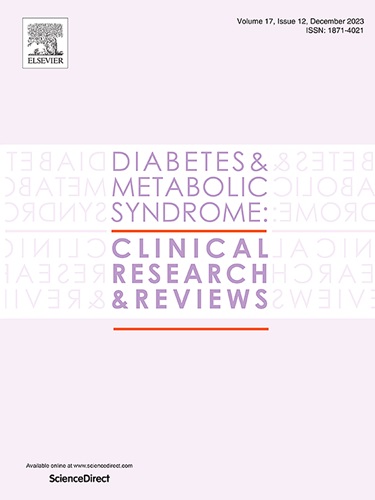远程医疗预防2型糖尿病的有效性:干预措施的系统回顾和荟萃分析
IF 3.4
Q1 ENDOCRINOLOGY & METABOLISM
Diabetes & Metabolic Syndrome-Clinical Research & Reviews
Pub Date : 2025-05-01
DOI:10.1016/j.dsx.2025.103252
引用次数: 0
摘要
目的评价远程医疗饮食和/或运动干预对高危人群预防2型糖尿病(T2D)的有效性。方法检索sembase(通过Ovid)、Medline(通过Ovid)、Web of Science、CINAHL、Scopus和SciELO,检索2010年1月至2020年12月通过远程医疗提供的饮食和/或运动干预对高危人群预防T2D的干预研究。对平行随机对照试验进行meta分析,并对其他干预设计进行叙述性综合。结果:我们通过数据库检索确定了11,645项研究,其中226项是全文筛选,包括52项干预措施;32例纳入元分析,20例纳入叙事综合。远程医疗干预降低了体重(平均差值(MD): - 1.66 kg, 95%可信区间(CI): - 2.48,-0.90, I2 = 81%, nstudies = 17),体重指数(MD -0.71 kg/m2, 95% CI -1.06,-0.37, I2 = 70%, nstudies = 11),腰围(MD -2.82 cm, 95% CI -5.16,-2.35, I2 = 84%, nstudies = 8)和糖化血红蛋白(MD - 0.07%, 95% CI -0.14,0.00, I2 = 71%, nstudies = 11)。其他临床结果未发现显著影响。叙事综合支持了结果。最长随访时间达24个月。我们的研究证明了远程医疗干预在高危人群,特别是超重/肥胖人群中预防T2D的有效性。本文章由计算机程序翻译,如有差异,请以英文原文为准。
The effectiveness of telemedicine in the prevention of type 2 diabetes mellitus: a systematic review and meta-analysis of interventions
Objective
To evaluate the effectiveness of telemedicine-delivered diet and/or exercise interventions to prevent type 2 diabetes (T2D) in people at risk.
Methods
Embase (via Ovid), Medline (via Ovid), Web of Science, CINAHL, Scopus and SciELO were searched from January 2010–December 2020 for intervention studies using a diet and/or exercise intervention delivered through telemedicine for T2D prevention in people at risk. Parallel randomised controlled trials were meta-analysed, and other intervention designs narratively synthesized.
Results
We identified 11,645 studies via database searches, of which 226 were full-text screened, and 52 interventions included; 32 were included in the meta-analysis and 20 in the narrative synthesis. Telemedicine interventions reduced body weight (mean difference (MD): −1.66 kg, 95 % confidence interval (CI) −2.48,-0.90, I2 = 81 %, nstudies = 17), body mass index (MD -0.71 kg/m2, 95 % CI -1.06,-0.37, I2 = 70 %, nstudies = 11), waist circumference (MD -2.82 cm, 95 % CI -5.16,-2.35, I2 = 84 %, nstudies = 8) and HbA1c (MD -0.07 %, 95 % CI -0.14,0.00, I2 = 71 %, nstudies = 11). No significant effects were found for other clinical outcomes. The narrative synthesis supported the results. The longest follow-up time was up to 24 months.
Conclusions
Our study demonstrates effectiveness for telemedicine-delivered interventions in preventing T2D in people at risk, specifically in people with overweight/obesity.
求助全文
通过发布文献求助,成功后即可免费获取论文全文。
去求助
来源期刊

Diabetes & Metabolic Syndrome-Clinical Research & Reviews
ENDOCRINOLOGY & METABOLISM-
CiteScore
22.90
自引率
2.00%
发文量
248
审稿时长
51 days
期刊介绍:
Diabetes and Metabolic Syndrome: Clinical Research and Reviews is the official journal of DiabetesIndia. It aims to provide a global platform for healthcare professionals, diabetes educators, and other stakeholders to submit their research on diabetes care.
Types of Publications:
Diabetes and Metabolic Syndrome: Clinical Research and Reviews publishes peer-reviewed original articles, reviews, short communications, case reports, letters to the Editor, and expert comments. Reviews and mini-reviews are particularly welcomed for areas within endocrinology undergoing rapid changes.
 求助内容:
求助内容: 应助结果提醒方式:
应助结果提醒方式:


